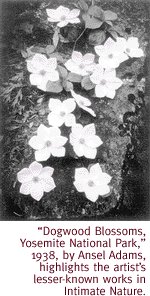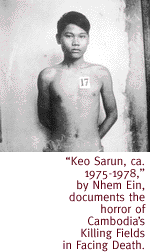

|

Scenic Fields Vs. Killing Fields At Center For Creative Photography.
By Margaret Regan
THE LEGENDARY PHOTOGRAPHER Ansel Adams spent a lifetime
canvassing the natural world, and left as his legacy some of the
most enduring images of the land ever made, from the monumental
peaks of the Western landscape to the microscopic swirls on an
ancient log.
A young photographer in Cambodia named Nhem Ein had an entirely
different mission. Working during the late 1970s in a prison operated
by the notorious Pol Pot regime, he photographed thousands of
his countrymen, women and children on their way to slaughter.
 Where Adams created beauty, Ein recorded horror.
Where Adams created beauty, Ein recorded horror.
Their two separate bodies of work, impossibly far apart in intention
and result, are both on view at the Center for Creative Photography
right now. Intimate Nature: Ansel Adams and the Close View
offers an atypical look at the beloved Adams. Instead of moons
rising over mountains and waterfalls tumbling down cliffs, this
other Adams provides 45 sublime close-ups of the minutiae of nature:
grass peeking through glistening snow, tree bark curving into
intricate patterns, leaves branching out into delicate spines
and ribs. Around a corner from these sumptuously printed art photos,
there's a cell-like installation for Facing Death: Portraits
from Cambodia's Killing Fields. Hung on portable walls stationed
uncomfortably close together, there are 100 stark black-and-white
portraits of Cambodians, accused traitors who stare at the teenage
photographer in terror and confusion. Babies and grandfathers,
young men and women in their prime, children on the cusp of puberty
are all frozen in time, captured as they were just before a tyrant
violently ended their lives.
It's hard to travel from one show to the other without entertaining
some somber thoughts about the strange capabilities of the human
race. A species that creates art as transcendent as Adams' is
the same species that slides easily and often into genocide. And
Adams' investigations of pebbles and pine needles are gorgeous
and uplifting, certainly, but how do we take pleasure in them
when we know that around the bend is a picture of an infant slumbering
in its mother's arms, about to be killed for crimes it never understood?
 Photography has proved equally adept at framing natural beauty
and documenting human ugliness. The Khmer Rouge, like the Nazis
before them, apparently had a mania for recording their own crimes.
Exhibition notes tell us that the Tuol Sleng prison was the torture
and death chamber for some 14,200 people, killed one and all by
their fellow Cambodians. (Altogether Pol Pot executed some 200,000
Cambodians; another million died of starvation, according to the
notes.) Functionaries like Nhem Ein photographed each victim and
then compiled a dossier for each that "proved" the charges
of treason.
Photography has proved equally adept at framing natural beauty
and documenting human ugliness. The Khmer Rouge, like the Nazis
before them, apparently had a mania for recording their own crimes.
Exhibition notes tell us that the Tuol Sleng prison was the torture
and death chamber for some 14,200 people, killed one and all by
their fellow Cambodians. (Altogether Pol Pot executed some 200,000
Cambodians; another million died of starvation, according to the
notes.) Functionaries like Nhem Ein photographed each victim and
then compiled a dossier for each that "proved" the charges
of treason.
In 1993, a pair of visiting American photographers uncovered
a repository of about 6,000 of the portrait negatives at the old
prison, now a museum of genocide. For this traveling show, they
made 100 prints of negatives that they considered both representative
and well-preserved. Some are damaged, pockmarked by black stains
that intensify the works' sense of foreboding. Artless and quick
the pictures might be--victims are lined up against walls or seated
on prison beds--but the power of their subjects is overwhelming.
Chan Kim Srun, the woman whose newborn child sleeps in her arms,
looks grimly out at us, in the sure knowledge that she and the
baby to whom she just gave life will soon die. A young man, Keo
Savith San, manages a slight smile, and it's hard to say whether
his misplaced optimism or the woman's hopeless certainty is more
heartbreaking. Most of the victims are anonymous, their names
having been long ago separated from their images. It's gratifying
that they have subverted the intentions of those who had them
photographed: exhibited this way, they've become enduring witnesses
to truth. That doesn't alleviate the injustice of what befell
them, though, and they're all haunting: The young man whose face
has been smashed in, the stoic grandfather, the lovely young woman,
the puzzled children.
You escape almost guiltily from their wretchedness, and it takes
awhile for Adams' pictures to beguile you back from the Cambodian
heart of darkness. But this lesser-known Adams work is seductive.
The observant photographer takes us into the microscopic world
that surrounds us unnoticed, and persuades us of the beauty of
mud cracked and dried in California, trees dead in Yosemite, stumps,
barnacles, ocean rocks and foam. Intimate in scale and quietly
lovely, these simple images have none of the showiness of Adams'
better-known landscapes.
 "The small and commonplace are rarely explored," Adams
wrote in 1983. "Most of my photographs made before 1930 were
of distant grandeurs. But as I learned the inherent properties
of camera, lens...and exposure, I also gained the freedom to see
with more sensitive eyes the full landscape of our environment."
"The small and commonplace are rarely explored," Adams
wrote in 1983. "Most of my photographs made before 1930 were
of distant grandeurs. But as I learned the inherent properties
of camera, lens...and exposure, I also gained the freedom to see
with more sensitive eyes the full landscape of our environment."
Culled entirely from the Center's own extensive Adams' holdings,
the show demonstrates Adams' move forward from old 19th-century
ideas about the camera capturing what was out there, to more 20th-century
ideas about the camera creating something entirely new, as curator
Trudy Wilner Stack notes. And indeed these sumptuous black-and-white
pictures, crisscrossed by nature's lines, illuminated by sunlight
and darkened by shadow, are heading directly for abstraction.
Can these pictures make up for the baby in the next room? No,
they can't. But they're beautiful, and in a world of inexplicable
evil, we take what we can get.
Intimate Nature: Ansel Adams and the Close View and
Facing Death: Portraits from Cambodia's Killing Fields
both continue through Sunday, March 1, at the Center for Creative
Photography on the University of Arizona campus. Ly Soung, a Cambodian-born
Tucsonan, will give a free gallery talk at 2 p.m. Sunday, February
22, describing his family's flight from the Khmer Rouge. Regular
gallery hours are 11 a.m. to 5 p.m. Monday through Friday, noon
to 5 p.m. Sunday. Admission is free. For more information call
621-7968.

|
 |





